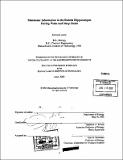Mnemonic information in the rodent hippocampus during wake and sleep states
Author(s)
Louie, Kenway, 1973-
DownloadFull printable version (7.607Mb)
Other Contributors
Massachusetts Institute of Technology. Dept. of Biology.
Advisor
Matthew A. Wilson.
Terms of use
Metadata
Show full item recordAbstract
To investigate the representation of information in the hippocampus during memory processes, we simultaneously monitored the spiking activity of many single neurons in freely behaving rats during spatial locomotor tasks and periods of sleep. The first experiment examined the effect of differential reinforcement on the hippocampal representation of space, as mediated by the spatial receptive fields, or place fields, of hippocampal pyramidal neurons. We show that there is a bias in both place field distribution and population spiking activity towards previously reinforced locations; restriction of analysis to periods of uniform behavior suggests that this inhomogeneity is a mnemonic effect. An inverted bias observed in hippocampal interneurons suggests a broadly distributed coding of this information across the hippocampal network. These results show that information regarding behavioral salience can reach the hippocampus, and becomes incorporated into a broad hippocampal representation of experience. The second experiment examines the reactivation of such behavioral memory traces in the absence of active behavior or sensory cues, specifically during offline-periods such as sleep. While experience-dependent reactivation occurs during slow-wave sleep, there is no evidence for such activity during REM sleep, despite its association with human dreaming and putative role in memory processing. We report that spatiotemporal patterns of activity - reflecting tens of seconds to minutes of behavioral experience - are reproduced during REM episodes at a roughly equivalent timescale. Furthermore, within such REM episodes behavior-dependent modulation of the subcortically driven theta rhythm is also reproduced. (cont.) Unlike the short bursts of compressed reactivation seen in slow-wave sleep, these patterns reflect the concerted reactivation of temporally-sequenced firing across multiple neurons over long durations, broadly structured enough to convey information regarding behavioral experience. Such reactivation may represent neural processes underlying memory transfer and consolidation, and provides a basis for the electrophysiological examination of mnemonic content in sleep and dream states.
Description
Thesis (Ph.D.)--Massachusetts Institute of Technology, Dept. of Biology, 2002. Includes bibliographical references (leaves 79-91).
Date issued
2002Department
Massachusetts Institute of Technology. Department of BiologyPublisher
Massachusetts Institute of Technology
Keywords
Biology.